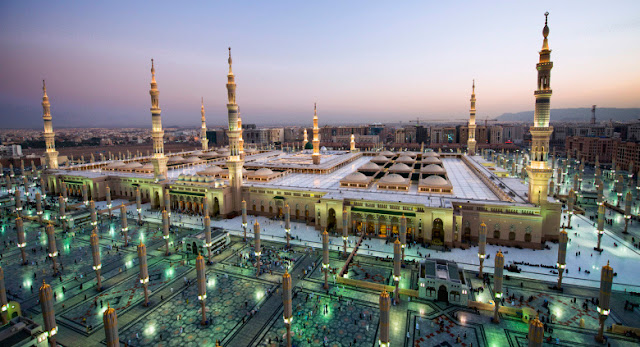Allah enjoins us to be kind on earth
ALLAH, the Almighty, says: “Allah commands justice, the doing of good, and liberality to kith and kin, and He forbids all shameful deeds, and injustice and rebellion: He instructs you that ye may receive admonition.” (Qur’an, 16:90)
Justice and fairness are commanded and required in all situations, when one is happy and satisfied, and when one is upset and unsatisfied, with Muslims and with non-Muslims alike. Allah, the Almighty, says: “O ye who believe! Stand out firmly for Allah, as witnesses to fair dealing, and let not the hatred of others to you make you swerve to wrong and depart from justice. Be just, that is, next to Piety; and fear Allah. For Allah is well-acquainted with all that ye do.” (Qur’an, 5:8)
Islam enjoins altruism and urges Muslims to practice it. Philanthropy and benevolence are some of the results of altruism, if practiced by the members of the society. Allah, the Almighty says: “But those who, before them, had homes (in Madinah) and had adopted the faith, show their affection to such as came to them for refuge, and entertain no desire in their hearts for things given to the (latter); but give them preference over themselves, even though poverty was their (own lot). And those saved from the covetousness of their own souls; they are the ones that achieve prosperity.” (Qur’an, 59:9)
Islam urges to maintain righteous company. Muslims are advised to stay aloof from bad company. Allah’s Messenger (peace and blessings of Allah be upon him) is reported to have said, The example of good and evil companions is like that of a person who is carrying musk and the blacksmith who is blowing his blower over the fire to get it going. A musk carrier would either give you a bit of it, or you may buy a little from him or at the least, you would smell good perfume from him. As for the blacksmith who is blowing his blower over the fire you may either burn your clothes (if you sit by him), or else you would be disturbed with the sparkles of his fire, or the least (harm you may get) is to get disturbed with the bad odor coming from him (and his place). (Bukhari and Muslim)
Islam enjoins to assist people in making up better relationships. This is especially so when there is a rift in the relationship between people. Allah, the Almighty says: “In most of their secret talks there is no good; but if one exhorts to a deed of charity or justice or conciliation between men, (secrecy is permissible): To him who does this, seeking the good pleasure of Allah, We shall soon give a reward of the highest (value).” (Qur’an, 4:114)
Islam suggests maintaining a good character and morals. Good morals and virtues are essential for a better society. Allah’s Messenger (peace and blessings of Allah be upon him) is reported to have said, Among the best believers are the persons with the best of morals and characteristics and those who are most kind to their family members. (Tirmidhi)
Islam enjoins on Muslims to offer their help and assistance to others free of charge and for the pleasure of Allah Almighty. Allah’s Messenger (peace and blessings of Allah be upon him) is reported to have said, Do favors for those who deserve to be done for them, and also for those who do not deserve to be done for them. If the doer did the favor for those who deserve it (and they are worthy of it) it is fine and good, and if not, the doer (of the favor) himself is one of those who are worthy for favors. (Tirmidhi)
Islam enjoins on Muslims to be generous. Generosity brings people closer to each other and enables the generous to gain the love and affection of others. Allah’s Messenger (peace and blessings of Allah be upon him) is reported to have said, “Allah, the Almighty, loves two traits: To be good to others and to be generous to them.” Similarly, Allah, the Almighty, hates two traits: To be mean to others and to be miser to people. On the other hand, If Allah, the Almighty, favors a person, He would employ him to assist others achieve their goals and fulfill their needs.
There is criterion, however, for generosity in Islam. Allah says: “Make not thy hand tied (like a niggard’s) to thy neck, nor stretch it forth to its utmost reach, so that thou become blameworthy and destitute.” (Qur’an, 17:29)
On being generous toward others, Allah, the Almighty, says: “And render to the kindred their due rights, as (also) to those in want, and to the wayfarer; but squander not (your wealth) in the manner of a spendthrift. Verily spendthrifts are brothers of the evil ones; and the evil one is to his Lord (Himself) ungrateful.” (Qur’an, 17:26-27)
Muslims to be kind and benevolent to others. The Prophet (peace be upon him) is reported to have said, “Allah, the Almighty, would be (extremely) kind and merciful to those who are kind and merciful to others. Be kind to those on earth, the One in Heaven would be kind and merciful to you.” (Tirmidhi and Abu Dawood)
Islam commands Muslims to be kind and accommodating to others and encourages people to do so. Allah’s Messenger (peace and blessings of Allah be upon him) is reported to have said, Being kind to others is good in every matter and if kindness is removed (from the hearts of people), the situation becomes worst. (Muslim)
Islam enjoins on Muslims to hide omissions of others, and help each other to achieve their decent and honest goals.
Allah’s Messenger (peace and blessings of Allah be upon him) is reported to have said, “Whosoever alleviates a believer’s hardship of this world, Allah, the Almighty, would alleviate his hardship and difficulty of the Day of Judgment. Whosoever eases the terms on (a financially) stranded person, Allah, the Almighty, would ease his difficulties in both this world and the Hereafter. Whosoever hides the defects of a Muslim in this world, Allah, the Almighty, would hide the defects of that person both in this world and in the Hereafter. Allah, the Almighty, would continue to assist a slave-servant so long as such person is extending his help and assistance to his Muslim brethren. (Muslim)
Islam enjoins upon patience. People are encouraged to be patient in order to perform their religious duties. People are equally urged and encouraged to practice patience in order to avoid all evils. Allah, the Almighty, says: “Now await in patience the command of thy Lord; for verily thou art in Our eyes; and celebrate the praises of thy Lord the while thou standest forth.” (Qur’an, 52:48)
Islam also urges and encourages Muslims to be patient on what they have been predestined for such as poverty, hunger, lack of resources, terminal illness or else, and fear.
In fact, Allah, the Almighty, illustrates the reward of the patient people as follows: “Say: O ye My servants who believe! Fear your Lord. Good is (the reward) for those who do good in this world. Spacious is Allah’s earth! Those who patiently persevere will truly receive a reward without measure!” (Qur’an, 39:10)
Islam enjoins Muslims to control their temper and forgive others, though one is capable to take revenge. Such attitudes, of course, strengthen the relationships and ties among people and create a better atmosphere within the society. Islam promised a great reward for controlling one’s temper. Allah Almighty says: “Be quick in the race for forgiveness from your Lord, and for a garden whose width is that (of the whole) of the heavens and of the earth, prepared for the righteous. Those who spend (freely), whether in prosperity, or in adversity; who restrain anger, and pardon (all) men; for Allah loves those who do good.” (Qur’an, 3:133-134)
Also, Allah Almighty commands to do well, even though they have done unwell and were mistreated with evil acts. All this is done with the hope that people would get closer to each other and mane forge affection toward to each other. Allah, the Almighty, says: “Nor can goodness and evil be equal. Repel (evil) with what is better: Then will he, between whom and thee was hatred, become as it were thy friend and intimate!” (Qur’an, 41:34)
Article by: arabnews.com








 Source: arabnews
Source: arabnews 











